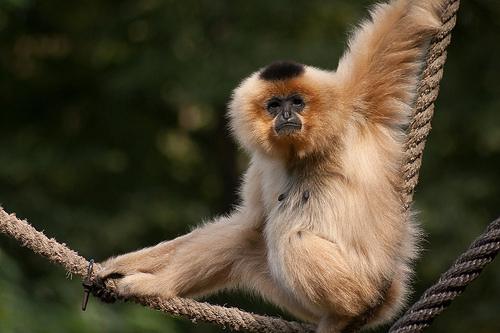Gibbons may be small, but they still are apes.
- Gibbons are a group of around 17 species of primate, that live in family groups in trees, in tropical forests of southeast Asia.
- The scientific name of the gibbon family is Hylobatidae, and they are from the superfamily Hominoidea, which is the group of apes.
- ‘Gibbons’ are also known as the ‘smaller apes’ or ‘lesser apes’, in comparison to the more well known ‘great apes’, and as an ape, they do not possess a tail.
- Gibbons grow to be around 44 to 90 centimetres (17 to 35 inches) in height and they generally weigh between 4 to 13 kilograms (9 to 29 pounds), depending on the species.
- The diet of gibbons is predominately fruit, especially figs, but it also consists of insects, leaves, flowers and sometimes bird eggs.
Gibbon
Image courtesy of Leszek Leszczynski/Flickr
- Typically, gibbons will have one partner for life, and the females usually give birth to one baby every two to three years, with the young taking roughly six to seven years to become independent; and they can have a lifespan of 25 years or more.
- The colour of gibbon hair is determined by the species and gender, and it can range from brown, grey, black, cream, and white – which is often evident around the face and sometimes on the feet and hands.
- Gibbons have a ball-and-socket like joint at their wrists, as well as long arms, that allow for swinging between trees at speeds of 56 kilometres per hour (35 miles per hour), making them one of the fastest tree-dwelling mammals in the world.
- When walking on two feet, either on the ground or on branches, gibbons use their arms to assist in balance; and they communicate with each other via calls and ‘songs’ with their loud voices.
- Primarily due to habitat destruction, all gibbon species in 2015, bar one, were considered critically endangered or endangered, which led the primate to come into the spotlight as the IUCN Species Survival Commission’s 2015 animal, to further encourage its conservation.
Bibliography:
Gibbon, 2016, A-Z Animals, http://a-z-animals.com/animals/gibbon/
Gibbon, 2016, National Geographic, http://animals.nationalgeographic.com.au/animals/mammals/gibbon/
Gibbon, 2016, Wikipedia, https://en.wikipedia.org/wiki/Gibbon







